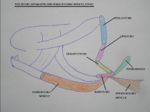Difference between revisions of "Hyoid Apparatus - Anatomy & Physiology"
Jump to navigation
Jump to search
m |
|||
| Line 35: | Line 35: | ||
*Stylohyoid | *Stylohyoid | ||
**Articulates with base of skull at petrus temporal | **Articulates with base of skull at petrus temporal | ||
| − | |||
**Paired | **Paired | ||
| Line 45: | Line 44: | ||
*Thyrohyoid | *Thyrohyoid | ||
| + | **Articulates with [[Larynx - Anatomy & Physiology#Thyroid Cartilage|thyroid cartilage]] of [[Larynx - Anatomy & Physiology|larynx]] | ||
**Paired | **Paired | ||
Revision as of 12:35, 28 September 2009
|
|
Introduction
The hyoid apparatus holds the larynx in place and supports the pharynx and tongue from the skull.
It is made up of 5 different bones which vary in length and size depending on the species.
Structure and Function
- Attached to the temporal region of the skull by a synchondrosis
- Palpable through pharynx
- Visible when the pharynx is viewed through the mouth
- Basihyoid is palpable within the intermandibular space
- Sternohyoid muscle pulls hyoid caudally
- Geniohyoid muscle pulls hyoid rostrally
The hyoid bones
- Basihyoid
- Lingual process present in some species which protrudes into the roof of the tongue
- Unpaired
- Stylohyoid
- Articulates with base of skull at petrus temporal
- Paired
- Epihyoid
- Paired
- Keratohyoid
- Paired
- Thyrohyoid
- Articulates with thyroid cartilage of larynx
- Paired
Species Differences
Carnivores
- Stylohyoid bones not palpable
Equine
- Epihyoid small
- Lingual process present
- Well developed stylohyoid muscle
Ruminants
- Lingual process present
Porcine
- Lingual process present


